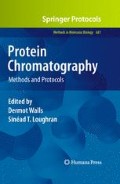Abstract
Where an affinity tag has served its purpose it may become desirable to remove it from the protein of interest. This chapter describes the removal of such fusion partners from the intended protein product by cleavage with site-specific endoproteases. Methods to achieve proteolytic cleavage of the fusion proteins are provided, along with techniques for optimising the yield of authentic product.
Access this chapter
Tax calculation will be finalised at checkout
Purchases are for personal use only
References
Marston, F.A. (1986) The purification of eukaryotic polypeptides synthesized in Escherichia coli. Biochem. J. 240, 1–12.
Nilsson, J., Stahl, S., Lundeberg, J., Uhlen, M. and Nygren, P.A. (1997) Affinity fusion strategies for detection, purification, and immobilization of recombinant proteins. Protein Expr. Purif. 11, 1–16.
Schechter, I. and Berger, A. (1967) On the size of the active site in proteases. I. Papain. Biochem. Biophys. Res. Commun. 27, 157–162.
Maroux, S., Baratti, J. and Desnuelle, P. (1971) Purification and specificity of porcine enterokinase. J. Biol. Chem. 246, 5031–5039.
Prickett, K.S., Amberg, D.C. and Hopp, T.P. (1989) A calcium-dependent antibody for identification and purification of recombinant proteins. Biotechniques. 7, 580–587.
Light, A. and Janska, H. (1989) Enterokinase (enteropeptidase): comparative aspects. Trends Biochem. Sci. 14, 110–112.
Nagai, K. and Thøgersen, H.C. (1984) Gen-eration of beta-globin by sequence-specific proteolysis of a hybrid protein produced in Escherichia coli. Nature 309, 810–812.
Blomback, B., Blomback, M., Hessel, B. and Iwanaga, S. (1967) Structure of N-terminal fragments of fibrinogen and specificity of thrombin. Nature 215, 1445–1448.
Chang, J.-Y. (1985) Thrombin specificity. Eur. J. Biochem. 151, 217–224.
Forsberg, G., Baastrup, B., Rondahl, H., Holmgren, E., Pohl, G., Hartmanis, M. and Lake, M. (1992) An evaluation of different enzymatic cleavage methods for recombinant fusion proteins, applied of des(1-3)insulin-like growth factor I. J. Prot. Chem. 11, 201–211.
Carter, P. and Wells, J.A. (1987) Engineering enzyme specificity by “substrate-assisted catalysis”. Science 237, 394–399.
Carter, P., Nilsson, B., Burnier, J.P., Burdick, D. and Wells, J.A. (1989) Engineering subtilisin BPN’ for site-specific proteolysis. Proteins 6, 240–248.
Allison, R., Johnston, R.E. and Dougherty, W.G. (1986) The nucleotide sequence of the coding region of tobacco etch virus genomic RNA: evidence for the synthesis of a single polyprotein. Virology 154, 9–20.
Lawson, M.A. and Semler, B.L. (1991) Poliovirus thiol proteinase 3C can utilize a serine nucleophile within the putative catalytic triad. Proc. Natl. Acad. Sci. U.S.A. 88, 9919–9923.
Carrington, J.C. and Dougherty, W.G. (1988) A viral cleavage site cassette: identification of amino acid sequences required for tobacco etch virus polyprotein processing. Proc. Natl. Acad. Sci. U.S.A. 85, 3391–3395.
Dougherty, W.G. and Parks, T.D. (1989) Molecular genetic and biochemical evidence for the involvement of the heptapeptide cleavage sequence in determining the reaction profile at two tobacco etch virus cleavage sites in cell-free assays. Virology. 172, 145–155.
Cordingley, M.G., Callahan, P.L., Sardana, V.V., Garsky, V.M. and Colonno, R.J. (1990) Substrate requirements of human rhinovirus 3C protease for peptide cleavage in vitro. J. Biol. Chem. 265, 9062–9065.
Kapust, R.B., Tozer, J., Copeland, T.D. and Waugh, D.S. (2002) The P1’ specificity of tobacco etch virus protease. Biochem. Biophys. Res. Comm. 294, 949–955.
Baratti, J., Maroux, S. and Louvard, D. (1973) Effect of ionic strength and calcium ions on the activation of trypsinogen by enterokinase. Biochim. Biophys. Acta. 321, 632–638.
Forstner, M., Peters-Libeu, C., Contreras-Forrest, E., Newhouse, Y., Knapp, M., Rupp, B. and Weisgraber, K.H. (1999) Carboxyl-terminal domain of human apolipoprotein E: expression, purification, and crystallization. Prot. Expr. Purif. 17, 267–272.
Zhang, H., Yuan, Q., Zhu, Y. and Ma, R. (2005) Expression and preparation of recombinant hepcidin in Escherichia coli. Prot. Expr. Purif. 41, 409–416.
Lien, S., Milner, S.J., Graham, D.L., Wallace, J.C. and Francis, G.L. (2001) Linkers for improved cleavage of fusion proteins with an engineered α-lytic protease. Biotechnol. Bioeng. 74, 335–343.
Francis, G.L., Aplin, S.E., Milner, S.J., McNeil, K.A., Ballard, F.J. and Wallace, J.C. (1993) Insulin-like growth factor (IGF)-II binding to IGF-binding proteins and IGF receptors is modified by deletion of the N-terminal hexapeptide or substitution of arginine for glutamate-6 in IGF-II. Biochem. J. 293, 713–719.
Holowachuk, E.W. and Ruhoff, M.S. (1995) Biologically active recombinant rat granulocyte macrophage colony-stimulating factor produced in Escherichia coli. Prot. Expr. Purif. 6, 588–596.
Polyak, S.W., Forsberg, G., Forbes, B.E., McNeil, K.A., Aplin, S.E. and Wallace, J.C. (1998) Introduction of spacer peptides N-terminal to a cleavage recognition motif in recombinant fusion proteins can improve site-specific cleavage. Prot. Eng. 10, 615–619.
Hakes, D.J. and Dixon, J.E. (1992) New vectors for high level expression of recombinant proteins in bacteria. Anal. Biochem. 202, 293–298.
Allison, R.F., Sorenson, J.C., Kelly, M.E., Armstrong, F.B. and Dougherty, W.G. (1985) Sequence determination of the capsid protein gene and flanking regions of the tobacco etch virus: evidence for synthesis and processing of a polyprotein in potyvirus genome expression. Proc. Natl. Acad. Sci. U.S.A. 82, 3969–3972.
Stanway, G., Hughes, P.J., Mountford, R.C., Minor, D.P. and Almond, J.W. (1984) The complete nucleotide sequence of a common cold virus: human rhinovirus 14. Nucl. Acids. Res. 12, 7859–7875.
Dougherty, W.G., Parks, T.D., Cary, S.M., Bazan, J.F. and Fletterick, R.J. (1989) Characterization of the catalytic residues of the tobacco etch virus 49-kDa proteinase. Virology. 172, 302–310.
Nallamsetty, S., Kapust, R.B., Tozser, J., Cherry, S., Tropea, J.E., Copeland, T.D. and Waugh, D.S. (2004) Efficient site-specific processing of fusion proteins by tobacco vein mottling virus protease in vivo and in vitro. Prot. Expr. Purif. 38, 108–115.
Author information
Authors and Affiliations
Editor information
Editors and Affiliations
Rights and permissions
Copyright information
© 2011 Springer Science+Business Media, LLC
About this protocol
Cite this protocol
Charlton, A., Zachariou, M. (2011). Tag Removal by Site-Specific Cleavage of Recombinant Fusion Proteins. In: Walls, D., Loughran, S. (eds) Protein Chromatography. Methods in Molecular Biology, vol 681. Humana Press. https://doi.org/10.1007/978-1-60761-913-0_19
Download citation
DOI: https://doi.org/10.1007/978-1-60761-913-0_19
Published:
Publisher Name: Humana Press
Print ISBN: 978-1-60761-912-3
Online ISBN: 978-1-60761-913-0
eBook Packages: Springer Protocols

